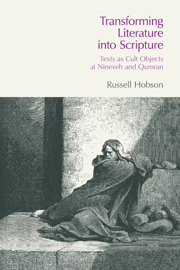Book contents
- Frontmatter
- Contents
- Acknowledgements
- Abbreviations
- 1 Authoritative Texts in the Hebrew and Cuneiform Traditions
- 2 Formulating a New Comparative Approach
- 3 Choosing the Right Texts
- 4 Study One: Enūma Anu Enlil Tablet 63
- 5 Study Two: Mul.Apin
- 6 Study Three: The Laws of Hammurabi
- 7 Study Four: Tablet XI of the Epic of Gilgamesh
- 8 Study Five: Mīs Pî
- 9 Study Six: Manuscripts of Pentateuchal Texts from Near the Dead Sea
- 10 Interpreting the Evidence
- Notes
- Bibliography
- Index of Ancient References
- Index of Authors
- Index of Subjects
6 - Study Three: The Laws of Hammurabi
- Frontmatter
- Contents
- Acknowledgements
- Abbreviations
- 1 Authoritative Texts in the Hebrew and Cuneiform Traditions
- 2 Formulating a New Comparative Approach
- 3 Choosing the Right Texts
- 4 Study One: Enūma Anu Enlil Tablet 63
- 5 Study Two: Mul.Apin
- 6 Study Three: The Laws of Hammurabi
- 7 Study Four: Tablet XI of the Epic of Gilgamesh
- 8 Study Five: Mīs Pî
- 9 Study Six: Manuscripts of Pentateuchal Texts from Near the Dead Sea
- 10 Interpreting the Evidence
- Notes
- Bibliography
- Index of Ancient References
- Index of Authors
- Index of Subjects
Summary
The Text
The following manuscripts represent copies made of a series of laws that stem from the Old Babylonian period, specifically to the rule of Hammurabi of Babylon. The composition is generally dated to the first half of the eighteenth century bce. The prologue, epilogue, and intervening laws were inscribed on a piece of diorite that stands approximately 225 cm tall, the upper portion of which is taken up by a depiction of the king standing before a seated deity, the latter presumed to be Šamaš. The text descends in horizontal bands down the front side and then the back side of the stele, increasing in length as the stele increases in girth towards its base. As can be determined from the ancient fragments, these Laws existed in more than one copy from an early point. The use of the Louvre stele (LH) as the Haupttext in the present study is due primarily to its relatively complete preservation, especially when compared to the other sources. Only seven columns of the lower portion of the front side of the stele have been effaced.
The Tablets
The first-millennium copies of the Laws of Hammurabi examined here are Neo-Assyrian and Neo-Babylonian in origin. None of the tablets originally contained the law code in its entirety. Rather, certain manuscripts appear to be parts of a series that, when complete, may have contained all of the text of the stele. The sigla employed below are based on those used by Borger, though some adjustments have been made to reflect joins that have since been suggested by other scholars.
- Type
- Chapter
- Information
- Transforming Literature into ScriptureTexts as Cult Objects at Ninevah and Qumran, pp. 62 - 74Publisher: Acumen PublishingPrint publication year: 2012



